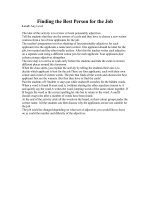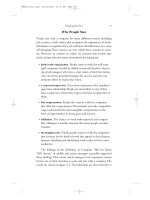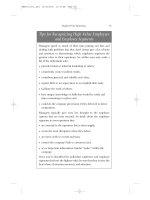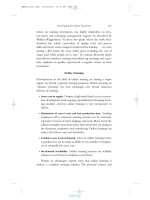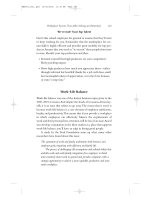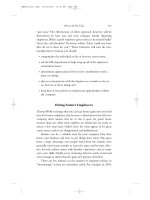Shopping Guide: Finding the best deals safely
Bạn đang xem bản rút gọn của tài liệu. Xem và tải ngay bản đầy đủ của tài liệu tại đây (1.63 MB, 40 trang )
Shopping Guide
By Tina Sieber
Edited by Justin Pot
This manual is the intellectual property of
MakeUseOf. It must only be published in its
original form. Using parts or republishing altered
parts of this guide is prohibited without permission
from MakeUseOf.com
Think you’ve got what it takes to write a manual
for MakeUseOf.com? We’re always willing to
hear a pitch! Send your ideas to
; you might earn up to
$400.
Table of Contents
Introduction
Online vs. Offline
How to Shop the Best Deal Safely
MakeUseOf
Introduction
Why an ebook about shopping?
These days, shopping is not merely a necessity of
life. With the rise of color magazines and TV in the
20th century, along with improved mobility and the
spreading of supermarkets, department stores, and
shopping malls; shopping has evolved from a
comfortable way to obtain required goods into
something pleasurable, a hobby and eventually
mass entertainment for an entire generation.
Psychologists, statisticians, graphic artists,
authors, and whatnot have teamed up and carved
out an elaborate niche for themselves: marketing.
That is the process to create the customer, keep the
customer, and satisfy the customer. In other words,
we are consumers and we must be fed.
What they do is create an artificial need in us. We
realize we need this item in order to be successful,
attractive or respected. Without this product, our
life is not complete. We have a problem and we
must solve it. This product is the key. In other
words, we need to buy this to be happy. While all
of these statements, in regards to any luxury item,
aren’t exactly true, we have to admit that it is a
pleasure to spend money on things that improve
life one way or the other. Yes, shopping is a
superfluous modern pleasure, just like taking a
shower every day. So what?
So you don’t get the best you deserve. This guide
will achieve three things: improve your shopping
experience, improve your shopping success, and
save you money. This guide outlines the necessary
steps you need to take, decisions you have to make,
and tools you can use to prevent being misled by
aggressive marketing. In short: take time, research,
compare and shop safely. Following these
recommendations will help you spend less money
and buy better products.
Credits: wengistein via Flickr
Hopefully, you will decide to spend the money you
save on something meaningful, such as an
emergency fund, health insurance or education of
yourself and/or your kids.
Online vs. Offline
Whether you shop for clothes, gadgets or
personalized gifts, first you must decide where to
start. Are you going to enjoy the comfort of
shopping from your couch or do you prefer to touch
and try what you’re going to purchase? Both
approaches have their pros and cons, and
sometimes it’s best to combine them.
Credits: ephotion via Flickr
Online shopping has a number of advantages. First
of all, you don’t have to leave your house. You can
shop anytime you want because online stores are
always open. You can do thorough research, read
customer reviews and objective product tests.
Furthermore, you can rapidly compare prices
across multiple online shops and hunt down the
best deal available. Doing this, you also save a lot
of time since you don’t have to push through
crowds, find what you want, compare prices from
one store to the next, and hide from overly helpful
and dangerously convincing sales assistants. Last
but not least, your shopping will be delivered to
your door, so you don’t even have to carry or
transport it. Really, leaving the house to shop is not
worth the hassle.
To sum up, you should shop online if you
• are short on time
• want to make sure you get the best deal
• hate crowds
• feel disturbed by sales assistants
• know exactly what you want
Credits: lemsipmatt via Flickr
On the other hand, shopping is a highly enjoyable
activity for many people. They love to browse
stores and chat with staff. Either way, old-school
shopping has many advantages, besides serving as
entertainment. While it may take more time to
compare and get a good deal, you will obtain
hands-on experience with the item you’re
examining. If you have to make a purchase
urgently, for example if you forgot your wedding
anniversary, you should not rely on the punctual
delivery of a parcel. Believe me, it’s better to rush
to a local store, spend a couple of bucks more, and
obtain a high quality gift, than to regret it later on.
Also, you won’t be alone in making your decision
because that’s what sales assistants are there for.
They will help you pick the right item. And relax;
you are not the first helpless person who doesn’t
know the exact size. Should you not be happy with
the price, you can still bargain for a better deal or
get something extra for free. Finally, during the
holiday season, many stores grant extended return
or exchange periods. So if you still made a
mistake, you can undo it easily.
Taken together, you should rely on old-school
shopping if you
• are in a hurry with making the purchase
• need to try the item and make sure it’s of good
quality
• depend on expert advice for your decision
• enjoy to bargain
• demand good and personal service in the long run
Credits: Morning-theft via Flickr
How to Shop the Best Deal
Safely
To become a true pro shopper, you must combine
online and offline shopping strategies. Here is a
little guide to point you along the way. This is
written with electronic devices in mind, but will
work similarly for clothes, shoes or jewellery.
Rule #1: Ask the Internet
Let’s say you would like to buy a new laptop. It’s
not a cheap item and you probably don’t need it
right now. No really, you don’t. But since you’re
going to use it for some time, it is worth investing a
little extra time and thought in the initial research
process. Start by getting an overview of what
features are available. And understand what they
do. Then evaluate which features you will really
need, which ones would be nice to have, and
which ones you can definitely live without. Be
honest. Now you have your minimum (need) and
maximum (nice to have) requirements.
For ideas about a product range you can ask
Google and see what it comes up with. If you need
some pointers on how to search Google like a pro,
check out my article Master the Google Operands.
Alternatively, you can browse any of the following
sites. These resources typically provide deeper
insights and more details than the average person
is patient enough to share with you.
ConsumerSearch
ConsumerSearch is an easy to navigate site that
provides short overviews and full reports on a
great range of products. Here you can find out
about ultraportable laptops, binoculars, freezers or
cat food. The “What To Look For” section
highlights the key characteristics of this product
category and you’ll find it easy to come up with
your minimal requirements based on these
recommendations. The “Full Report” goes into
details and usually comprises several chapters and
links that lead to even more information. Besides
providing background information, the site
aggregates reviews from various sources including
Gizmodo, PCMag.com, ConsumerReports.org,
CNET, Amazon.com and About.com. Based on
these reviews, the “Top x Best Reviewed” items
are compiled for each product category. Finally,
you can go ahead and compare prices for
individual products.
Consumer Reports
Some parts of Consumer Reports are restricted to
registered users. The membership is not free.
However, the “Buying Advice” is freely
accessible and very well written. Consumer
Reports covers a similar selection of product
categories as ConsumerSearch: Appliances,
Electronics, Home & Garden, and Babies & Kids.
You will find comprehensive but concise articles
that give an overview of product types, explain
every feature you can imagine, and introduce the
major brands. Moreover, many product categories
contain a buying guide video tutorial, which is far
more comfortable to consume than text. The best
section, however, is “Shopping tips”. It contains
invaluable leads and advice, which you should
definitely consider before making your decision.
With these two sites and Google, you should
quickly reach a decision regarding your minimum
and maximum requirements. But beware!
Rule #2: Get What You Want!
If you take these requirements to a shop, they may
try to sell you what they have. It’s not necessarily
the best item for you and more likely than not, it
will not be the best deal. In an ideal world, price
and quality should determine which of your
requirements can be fulfilled, not the stock of your
local department store.
So before you head out, continue your online
research and make a preselection. Select all
models that fulfill your requirements and have
received good reviews. Using the product reviews
and recommendations of ConsumerSearch and
Consumer Reports, you may have picked some
favorites already. But go ahead and query some
more resources to see whether your selection hold
true.
While you’re at it, take note of what your desired
models approximately cost online.
Buzzillions
At Buzzillions you can rapidly select your
minimum or maximum requirements from different
categories and receive a list of matching products.
The list can be sorted by rank, most reviewed,
price, and novelty of the product.
Each product receives a short summary. Reviews
as well as a list of “Where to Buy” to get the best
deal are presented on separate pages. Furthermore,
you can add favorite items to your personal list,
which appears at the bottom of the page. And this
leads us to a killer feature of this website.
Once you have selected a couple of products, you
can click the respective button in the list to
compare your picks side by side. These data are
incredibly useful in further downsizing your list
and selecting only the products that best suit your
need.
Buzzillions is not limited to Electronics and
Computers. It also contains information and
reviews on several more categories: Sports, Home
& Garden, Health & Beauty, Clothing, Shoes,
Toys, Baby, and Books. Should you be looking for
gifts, this tool may work quite well as a
recommendation engine.
ProductWiki
Being a ProductWiki, the content of this site is
managed entirely by its audience. And it features
one of the longest product category lists of all sites
mentioned here. To access this list, select
products. But you can also search the wiki for a
specific product.
Once landed in your desired product category,
you’ll notice the list of features to the right. This is
where you can again select your minimum or
maximum requirements and filter out only matching
products. The options appear to be far more
refined than on the previous page. However,
ProductWiki is lacking the possibility to compare
selected products.
The product page holds all available details about
the item. Especially the Pros & Cons and the list of
Competitors are highly valuable. The Where to
Buy (best deal) guide is provided by PriceGrabber
and you can easily fetch prices for the UK, US, and
Canada.
Expo
Expo is an online community that focuses on
product video reviews. The reviews are provided
by the site’s members. Don’t expect professional
advertisements. The videos are amateurish, yet
clear and most importantly, honest.
Similar to the previous two sites, you can refine
search results by selecting certain specs from a
list. You can then sort the results by four different
criteria: Featured, Most Viewed, Highest Rated,
and Most Reviewed. Finally, you can watch the
video reviews and compare prices.
Rule #3: Try Before Your Buy
Now that you know what you want, you can head
out and visit a local store. Seeing, touching, and
testing different laptops will make the decision of
which model to get a lot easier.
Credits: pinksherbet via Flickr
Once you have seen all your favorite models and
fell in love with one of them, you have two
options: you can either go back home and get the
best deal online or you can play it safe (i.e.
immediately satisfy your need) and buy from your
local trusted dealer. Having gathered information
about what the new computer would cost online, at
least puts you in a great position for bargaining.
Rule #4: Compare Prices
Unless you have already been convinced, this is
the time to seriously compare prices and hunt
down the best deal. Of course, for obvious
reasons, it may still be your local trusted dealer.
Comparing prices is a tricky business. Since
MakeUseOf readers are spread across the globe,
this guide cannot recommend just one site.
However, introducing one price search engine for
every major country would exhaust the capacity of
both this guide and its author. Hence, here is a
single example of what to expect from a price
comparing website and how to use it. Please find a
suitable tool for you, for example on MakeUseOf.
Also, several of the websites mentioned above
feature price comparison.
PriceRunner
PriceRunner provides impartial price comparison
for the UK (link above), France, Germany, Austria,
Sweden, and Denmark. You need to make your
country selection on the bottom left.
If you are looking for the price of a specific item,
simply enter the product name in the search field
and hit “Search”. If the product name wasn’t
